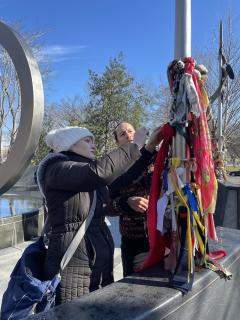Celebrating our new path: Renewing our commitment to Tribes
As an agency, we experienced a monumental shift when we published Strengthening Tribal Consultations and Nation-to-Nation Relationships: A USDA Forest Service Action Plan.This tribal action plan is the culmination of hard work, hard truths and fast learning.
On Feb. 1, I was honored to be a part of an event celebrating our new path forward. My leadership team met for a three-day workshop in Washington, D.C., so we decided to visit the National Museum of the American Indian to learn about Lakota traditions and beliefs from Reed Robinson, Sicangu [Seechawngu] Lakota, who also happens to be our director of the Office of Tribal Relations.
We gathered just outside the museum around a small circle embedded in the pavement that represented a medicine wheel. Robinson shared the importance of the medicine wheel to the Lakota people in nature, astronomy, traditional ceremony and life. The medicine wheel represents, among other concepts, the seven cardinal directions: West, North, East, South, above, below and center. The center also represents the self, so we took time to reflect and be still.
Robinson prepared us for a ceremony meant to spiritually cleanse us and our surroundings and to bless our efforts. He handed me a long red cloth, or prayer flag, with a round bundle of tobacco at one end. He lit sage and placed it in a small red bowl of pipestone (Catlinite) before using a Wiyaka, or eagle feather, to fan the smoke around the circle where we stood.
I reflected on the weight of leadership when Robinson stopped in front of me and John Crockett, our associate deputy, and placed the Wiyaka momentarily on us.
We understood the importance of what Robinson shared. This public show of tribal traditions carried deeper meaning because for years tribal members were not allowed to hold ceremonies in public spaces. That didn’t change until 1978 with the passage of the American Indian Religious Freedom Act. After the ceremony, we each left tobacco as an offering of respect for the land before moving over to the National Native American Veterans Memorial, which pays homage to Native heroes who served every military branch.
The memorial, dedicated in November, is a large, stainless-steel circle balanced on a large carved stone drum with cascading water. This circular design incorporates seating for the public through four openings, or gates, aligned West, North, East and South.
The North and South gates are guarded by four lances adorned with eagle feathers. On these, veterans, family members, tribal leaders and others can tie cloths for prayers and healing.
Robinson shared his traditions with us, helping us to be together as one, clear our thoughts and center ourselves. We quietly, ceremoniously, transitioned our unit’s name from State and Private Forestry to State, Private, and Tribal Forestry. We tied our flag to the southwest lance with the eagle features. To me, it represented a start of a new year and a new beginning.
State, Private, and Tribal Forestry, in name and intent, reflects the agency’s solemn commitment and nation-to-nation responsibility to Native Americans, Alaska Natives and Native Hawaiians. Words matter. Names are meaningful. This name change recognizes and elevates the work we do with sovereign tribal nations.
The name change does not change any of our responsibilities. Rather, we now have a more purposeful path. This day brought me closer to a clearer understanding. I’m proud to lead the unit holding our tribal trust but working with Tribes is something we all must do.
Editor's Note: Provide feedback about this column, submit questions or suggest topics for future columns through the FS-Employee Feedback inbox.


